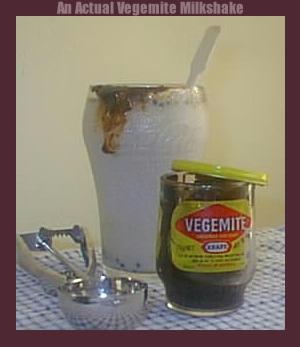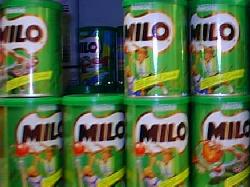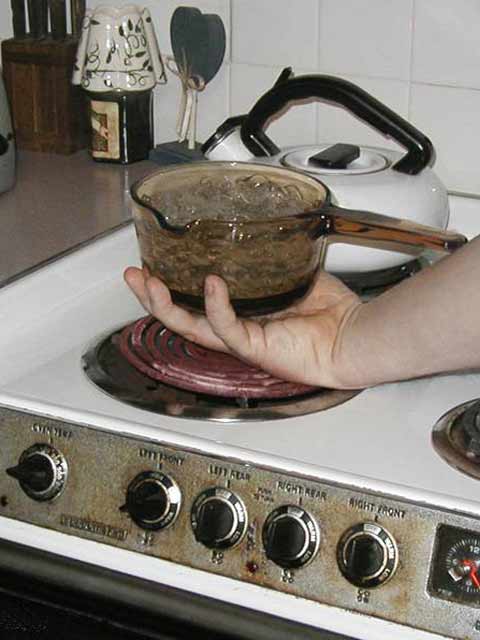Unusual Desserts
What's That?Just think of all those women on the Titanic who said, "No, thank you," to dessert that night. And for what! - Erma Bombeck When we decode a cookbook, every one of us is a practicing chemist. - Arthur E Grosser Beetroot Chocolate CakeThis is a Kiwi version of "What am I eating?" Serves 16 1 3/4 cups unbleached flour Castor sugar for dusting
I have two comments. The first concerns the fact that the ingredients are listed in ounces, cups, and teaspoons rather than in the metric measurements which are in official use in New Zealand. The pan size is even specified in inches. However, the temperature is given in centigrade. (Picture frames are also generally measured in inches, though computer paper comes in metric sizes.) The second comment concerns the use of the word "improve". I haven't yet tried this recipe, but if you should happen to, please drop me an email and let me know if they could've just as easily said "develop" flavour or if they really, truly meant "improve". Thanks. I'd really appreciate that.
-------- Original Message -------- This message was posted via the Feedback form Comments: in relation to the chocolate and beetroot cake: the taste really does improve with the extra time in the fridge although i find it improves better if left at room temperature. Dear Richard Why, thanks.
Marshmallow CakeThis recipe comes from the back of a Safeway marshmallow bag in 1954.
Delicious! Serves 2. Source: theava.com from the inimitable Charmian
Vegemite Milkshake
Okay - this isn't anything I would call dessert, but it doesn't fit into any other category and is definitely unusual, so I thought I might as well include it here... Vegemite (a black substance made of Concentrated Yeast Extract) First put two tablespoons of Good Aussie MILO (chocolate drink mix) in the bottom of a milkshake glass. Lightly spread one thin layer of Vegemite over the Milo to seal in the chocolate flavour. Briskly whip two eggs and pour on top of the Vegemite layer. Take one ice-cream scoop and, while still in the ice-cream scooper-spoon, cover generously with Vegemite so it is completely black. Add milk slowly and mix in the stock-cubes. Carefully drop the ice-cream scoop into glass from a height of 13 inches (precisely - the proven scientific height that lets the Vegemite ice-cream scoop perfectly diffuse into the milk; any lower and the Vegemite will sink, any higher and the glass may explode). Sprinkle with nutmeg or top with cream. Take very hot chilli pepper and chew it VERY SLOWLY so as to completely numb any sensation in your throat. Clean up the splatters, then enjoy your fair-dinkum Aussie Vegemite milkshake! Great at breakfast or to ease that mid-afternoon hunger-craving. Source: greggles.tripod.com/index2.htm
And no, I have never tried this recipe either. Furthermore, it is highly unlikely that I ever will. But who knows? It might even be edible - at least someone thought so...
Note:For another very unusual (and delicious) dessert, please see the recipe for Tortilla Torts. For a discussion of some of the unusual things humans eat, see Bon Appetit. Or, how about an apple or (excuse me please) a booger (see below)...
Not a Dessert, but an Interesting Recipe Nonetheless
I'm going to tell you how to make the best tomato sauce you have ever tasted in your life.
Place in a oven, heated to 285ºF. Yes, you read that right. You don't need to preheat, because the whole point is that it's the slowest cook ever. Just stick the tomatoes in there, and LEAVE. Go away for hours. Who cares. Don't even bother looking at it for at least 4 hours. But 6 would be okay too. If you turn down the heat even lower, you could be gone all day. While you're out, the tomatoes and peppers will be roasting like fallen angels. The tomatoes will release a great deal of their juice, making "tomato liquor." If you want to, you can drain off this liquor and use it for all kinds of incredible sauces and soups... it's the most profound tomato moonshine you'll ever toss back. If that is the case, you would then save the tomatoes separate from the liquor and use them as you please: from the spoon to your mouth, or any other dish that cries for red fruit. But let's say spaghetti is your mantra. In that case, you don't separate anything. Pour the whole roasted pan of melted peppers and tomatoes into a saucepan - or if you used the Dutch oven, place it on the stove. Throw in a handful of fresh basil leaves, or some fresh oregano if you want. Some sauteed onions would be good. Or you could have roasted the onions too, in the same fashion, if you wanted. Now you need to plug in the world's greatest appliance since the Cuisinart: The Immersion Blender. It's the Magic Wand of cooking. You plunge it into any mélange and it blends the ingredients into perfect sauce. Note that I did not skin or blanch the tomatoes or peppers! That is the labour that usually takes hours and drives everyone insane. But by slow roasting, the skin becomes so tender and delicious, all bitterness disappears. The blender then purees the crepe of the skin into oblivion. Dip into the pan with your spoon and taste the results. You are going to not believe that you could have made something so divine, so deep, like a Sicilian oracle. This is the miracle of slow roasting. Make your pasta, dunk your bread, pour it over your head. Whatever seems right... Source: susiebright.blogs.com
How to Boil Water
Source: worth1000.com Required:
Instructions:
Tips:
Bonus tip:
Warning: Boiling water can be dangerous! Take care not to spill it on yourself or anyone else as boiling water can cause burns. Source: dullmen.com/recipes.htm
Applesby Candee M Cintron Esquire Ate an apfel avore gwain to bed, Although the author of this old English saying is unknown, the phrase "An apple a day keeps the doctor away" became popular in this country when J T Stinson used it in his speech at the 1904 St Louis Exposition. There is dispute as to exactly where the apple - a member of the rose family - originated. However, most believe it was first cultivated in southwest Asia. During ancient Greek and Roman times, the apple played a crucial role in culture, legend and myth. The apple being one of the oldest recorded fruits and considered an item of luxury, it was traditionally associated with love, health, wisdom, temptation, sexuality, fertility, immortality and reincarnation. Although the biblical story of Adam and Eve is familiar to many of us, some experts believe Adam's forbidden fruit was not an apple, but instead, a pomegranate or quince. Still, the term "Adam's Apple" is derived from the protrusion in Adam's throat allegedly caused by a piece of the forbidden fruit that became lodged on that fateful day in the Garden of Eden. In actuality, a so-called "Adam's Apple" is the thyroid cartilage in one's neck. In 900AD, Mohammed was portrayed inhaling eternal life by inhaling the scent of an apple brought to him by an angel. In England, it was considered sacrilegious to destroy an apple orchard. When the trees were harvested, at least one or two apples would be left hanging as a gift for the birds, to ensure a prosperous harvest the following year. To this day, apple slices dipped in honey are eaten during the Jewish celebration of Rosh Hashanah, in anticipation of a sweet new year. Apples are also steeped in superstition. In Celtic culture, women would peel an entire apple in one long strip and toss it over their left shoulder. When it fell to the floor, it would supposedly form the shape of the initial of their future spouse. In that same vein, the best bobber of apples on Halloween was practically guaranteed to wed. The tradition of throwing rice at weddings is actually derived from the ancient practice of throwing apples. Ouch!!! Danish folklore held that if an apple withered in one's presence, that person was an adulterer. Apples were also thought to be the cure for whatever ailed you. Eating an apple with a holy name written on it for three days in a row, was said to get rid of a fever. Apples were also believed to miraculously make warts disappear by cutting the fruit into small pieces, rubbing one piece on each wart, and then burying the pieces in the ground. Greek physicians Galen and Hippocrates were proponents of eating sweet apples with meals to aid in digestion, or using sour apples to help with fainting and constipation. To this day, researchers at the Smell and Taste Treatment and Research Foundation in Chicago contend that the smell of green apples can help to alleviate a case of claustrophobia. By 1100AD, Roman physicians were being taught that apples aided bowel, lung and nervous system ailments. Additionally, apples were said to help rheumatism and apple juice was often prescribed as an antidepressant. Although some credit Columbus with bringing apple seeds to America, most are of the opinion that colonial settlers to New England were the first to begin harvesting the trees. In the early 1600s, Governor John Endicott brought the first apple tree to Massachusetts. Shortly thereafter, Clergyman William Blaxton (also referred to as "Blackstone") planted the fIrst orchard - on Beacon Hill in Boston, of all places! Ten years later, Mr B1axton moved to Pawtucket, Rhode Island, where he then planted that State's first apple orchard. Today's Sweet Rhode Island Greening was originally called "Blaxton's Yellow Sweeting." Generally speaking, apples quickly became an integral part of colonial diet and were eaten as part of each and every meal on a daily basis. Part of the reason the apple remained so popular, was because it could be safely stored throughout the cold winter months, providing a continuous source of fruit nutrition. In 1665, English mathematician Sir Isaac Newton developed the law of gravity by noticing that when juxtaposed with the rising moon, a force appeared to be drawing apples off the trees in his orchard, pulling them to the ground. In order to figure out exactly how this was occurring, Newton created calculus and the law of gravity followed. Around the turn of the 19th Century, John Chapman of Leominster, Massachusetts felt it incumbent upon him to spread the goodness of the apples he had so come to love. He filled his pockets and a huge sack with apple seeds or "pips" obtained from western Pennsylvania cider presses, with which he planted nurseries in the wilderness stretching from Pennsylvania to Indiana. Along the way, Mr Chapman was dubbed "Johnny Appleseed." He was known to be of a gentle and generous spirit and at times, was able to resolve disputes between settlers and Indians along the way. Johnny Appleseed died in 1845 in Fort Wayne, Indiana. In 1966, the United States Postal Service issued a commemorative stamp in his honour. Second only to China, America is one of the world's leading apple producers. It is believed that this country's generally hot summers and cold winters culminate to provide the perfect environment for growing apples. Although apples are grown to some extent in every single state, Washington produces the most apples at 50%, followed by New York, California, Michigan and Pennsylvania. In case you were wondering, the Red Delicious is the most popular variety, followed by the Golden Delicious and Fuji. New Jersey ranks a respectable 14th place, with its 4,100 acres of orchards which began producing apples as early as 1632. How many of us can easily forget the "Big Apple" tourism slogan of the 70s? Interestingly, this name was derived from the New York City horse racing courses of the 1920s. Established as "big money" races and the apple having always been a desirable fruit, the purses were named "big apples." In the late twenties, African American musicians, dancers and actors began using the term "Big Apple" in reference to landing a gig in the industry's most coveted location: New York City. Although the phrase lost momentum in the 50s and 60s, it returned in the 70s, never to be forgotten again. All in all, an apple a day can apparently keep the doctor away - so to speak. Apples do not contain any fat, cholesterol or sodium. Apples do contain healthy antioxidants, a lot of fibre, the mineral boron, and a small amount of potassium. As such, this popular fruit promotes a healthy heart, helps to lower blood pressure, reduces the risk of some cancers, and helps to strengthen bones. European medical researchers have also recently discovered that increased apple consumption promotes healthy lung function. And, as a side benefit, eating a whole apple, including the peel, can help to clean and whiten teeth. Source: 50 Plus October 2003
Physician Recommends Picking Your Nose and Eating ItPicking your nose and eating it is one of the best ways to stay healthy, according to a top Austrian doctor. Innsbruck-based lung specialist and professor Dr Friedrich Bischinger said people who pick their noses with their fingers were healthy, happier and probably better in tune with their bodies. He says society should adopt a new approach to nose-picking and encourage children to take it up. Dr Bischinger said: "With the finger you can get to places you just can't reach with a handkerchief, keeping your nose far cleaner. And eating the dry remains of what you pull out is a great way of strengthening the body's immune system. Medically, it makes great sense and is a perfectly natural thing to do. In terms of the immune system the nose is a filter in which a great deal of bacteria are collected, and when this mixture arrives in the intestines it works just like a medicine. Modern medicine is constantly trying to do the same thing through far more complicated methods, people who pick their nose and eat it get a natural boost to their immune system for free." He pointed out that children happily pick their noses, yet by the time they have become adults they have stopped under pressure from a society that has branded it disgusting and anti social. He said: "I would recommend a new approach where children are encouraged to pick their noses. It is a completely natural response and medically a good idea as well." And he pointed out that if anyone was really worried about what their neighbour was thinking, they could still enjoy picking their nose in private if they still wanted to get the benefits it offered. Source: ananova.com March 2004 For other unusual foods, see also:
For articles related to lifestyles including guns, television, extortion, hair, handbags, parenting, time bind, desserts, fitness, feasting, friends, happiness, ageing and more,
click the "Up" button below to take you to the Index for this Lifestyles section. |
 Animals
Animals Animation
Animation Art of Playing Cards
Art of Playing Cards Drugs
Drugs Education
Education Environment
Environment Flying
Flying History
History Humour
Humour Immigration
Immigration Info/Tech
Info/Tech Intellectual/Entertaining
Intellectual/Entertaining Lifestyles
Lifestyles Men
Men Money/Politics/Law
Money/Politics/Law New Jersey
New Jersey Odds and Oddities
Odds and Oddities Older & Under
Older & Under Photography
Photography Prisons
Prisons Relationships
Relationships Science
Science Social/Cultural
Social/Cultural Terrorism
Terrorism Wellington
Wellington Working
Working Zero Return Investment
Zero Return Investment


